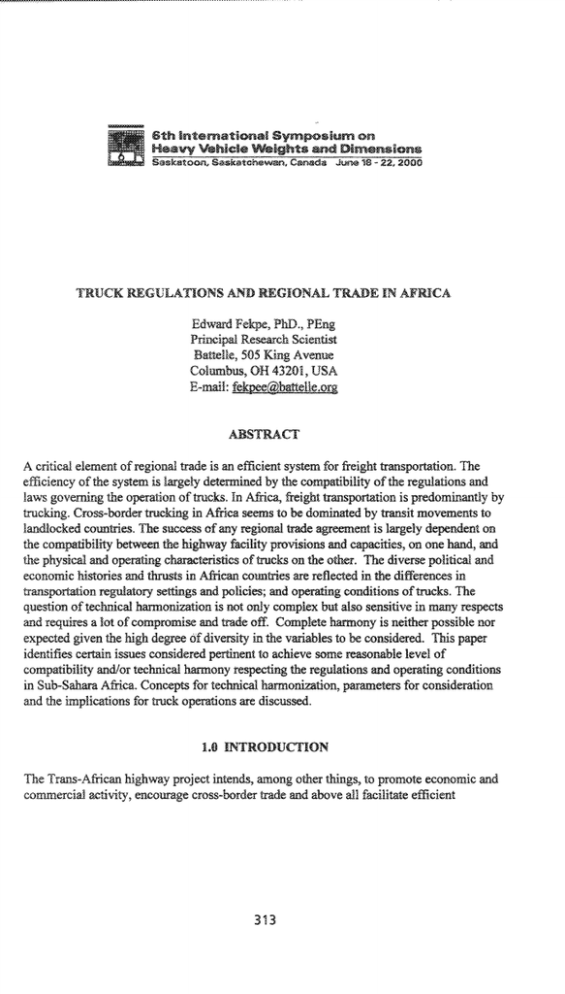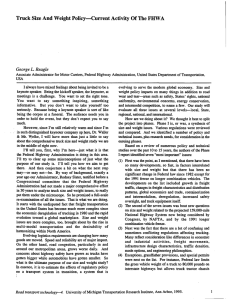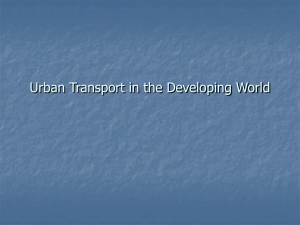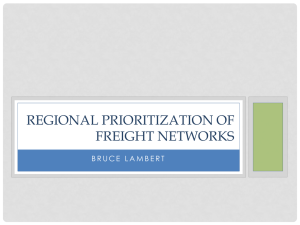e""k ..
advertisement

6th Intemational Symposium on
Heavy VimhicJe Weights and Dim_lenG
Saskatoon,
e""k..tchewan, Canada
....me 113 • 22, 2000
TRUCK REGULATIONS AND REGIONAL TRADE IN AFRICA
Edward Fekpe, PhD., PEng
Principal Research Scientist
Bauelle, 565 King Avenue
Columhus, OH 43201, USA
E-mail: fekpee@battelle,org
ABSTRACT
A critical element of regional trade is an efficient system for freight transportation. The
efficiency of the system is largely determined by the compatibility of the regulations and
laws governing the operation of trucks. In Africa, freight transportation is predominantly by
trucking. Cross-border trucking in Africa seems to be dominated by transit movements to
landlocked oountries. The success of any regional trade agreement is largely dependent on
the compatibility between the highway facility provisions and capacities, on one hand, and
the physical and operating characteristics of trucks on the other. The diverse political and
economic histories and thrusts in African countries are reflected in the differences in
transportation regulatory settings and policies; and operating conditions of trucks. The
questioo of technical harmonization is not only complex but also sensitive in many respects
and requires a lot of compromise and trade off. Cumplete harmony is neither possible nor
expected given the high degree Of diversity in the variables to be considered. This paper
identifies certain issues considered pertinent to achieve some reasonable level of
compatibility and/or technical harmony respecting the regulations and operating conditions
in Sub-Sahara Africa. Concepts for technical harmonization, parameters for consideration
and the implicatioos for truck operations are discussed.
1.0 INTRODUCTION
The Trans-.J\fii.can highway project intends, among other things, to promote economic and
commercial activity, encourage cross-border trade and above all facilitate efficient
313
movement of goods and services. It is recognized that inter-jurisdictional differences in
highway infrastructure provisions and capacities, transport regulatory policies, and
enforcement practices exist. A critical element of regional trade is an efficient and
harmonized system for freight transportation. In Africa, freight transportation is
predominantly by trucking with rail playing 8.'1 il'..significlL.'1t role. The success of any
regional trade agreement is largely dependent on the compatibility between the highway
facility provisions and capacities, on one hand, and the physical and operating
characteristics of the freight vehicles on the other. The diverse politicai and economic
histories and thrusts in African countries are reflected in the differences in transportation
regulatory settings and policies; and operating conditions of freight vehicles. It is important
therefore to attempt to rationalize these differences through teclmical harmonization of the
regulations and modalities of operation between jurisdictions.
A number of issues considered pertinent in achieving some reasonable level of
compatibility andIor technical harmony respecting the regulations and operating conditions
are addressed. These are necessary in the search for promoting competitiveness and
regional trade in Africa. Concepts for technical harmonization, and some implications for
truck operations are discussed. Experiences from some recent free trade agreements in other
parts of the world are also reported.
2.0 REGULATIONS AND FREIGHT MOVEMENT
The regulations governing the sizes, weights and operating conditions of vehicles are
intended to ensure safety, control highway infrastructure damage and improve productivity
of truck operations. They are structured to accommodate the physical interdependencies
which exist between publicly-provided roads and bridges and privateJy-operated vehicles;
to provide reasonable compatibility between the wide range of vehicle types 'Which must
share the public highways. Regulations do not exist to: (i) restrict truck size and to protect
railways from big trucks; (ii) protect the market of one trucker or any other interest from the
other; (iii) one country from another, or the industries of one country from those in another.
In many countries, the efficiency of all sectors of the economy relies on the efficiency of
freight movements. Available modes for freight transportation are trucks, rail, water and air
transport. In Africa, where the alternative rail and water transport do not offer any
significant competition, monopoly by trucks is clearly evident. Trucking accounts for 80 90"10 of freight transportation. Trucking activity on the African continent therefore is vital
for all economic activities. The discussion presented in this paper focuses on freight
movement by truck and develops concepts for rationalizing the size and weight limits to
facilitate free and efficient movement of freight between African countries.
The economies of African countries are similar and basically agricultural-based with
countries in a geographic region producing similar products. Exports are dominated by
314
relatively low value Wlprocessed agricultu.ral, mining and forestry products. These are
normal! y transported by trucks and rail (trucks dominating) from production centers to the
ports and major market cenlers. Imported goods from outside Africa include agricultural
inputs like fertilizers, manufactured products, machinery, vehicles etc. With the high
dependence on tnlcks, bulky and low value raw agricultural commodities, which are more
efficiently moved by rail, tend to be transported by trucks. Given the similarity in
economic and commercial activities, cross border trucking is dominated by movements
between the sea ports to landlocked countries.
3.0 REASONS FOR RELA TORY DIFFERENCES
It is practically impossible to achieve uniformity in the regulations across jurisdictions in
any given geographic region. In attempting to address the issue of technical hannonization
of size of weight regulations it is important to undersland why the regulations are different.
Within the African context (i.e ., non-vehicle manufacturing counlries) three possible
reasons are identified:
3.1 Regulatory Origin
The regulations in at! African countries (where they exist) are derived from some parent set
of regulations normally, those of the colonial masters and in most cases, have not been fully
adapted to the operating conditions, engineering design standards, and institutional
framework prevailing in these countries. The regulations in the English speaking African
(Anglophone) coWltries tend to be similar to those of United Kingdom, while regulations of
French speaking (Fraoophone) countries resemble those of mainland Europe in many
respects. Some countries, for one reason or the other, might have revised their regulations
since independence.
3.2 Differences in Transportation Needs and Problems
Different regulations have their roots in the different transport needs and issues.
Differences in terrain, subgrade and construction material drive highway design and
construction standards including strength of pavements and bridges; road geometry drive
the limitations on the dimensions of freight vehicies and highway infrastructure design
standards. Similarly, the economic activities influence the choice of desirable truck
characteristics. Availability of funds to construct, maintain and upgrade the highway
infrastructure to meet the requirements of the vehicles will influence the flexibility to revise
existing regulations to accommodate new and probably heavier vehicie configurations. The
economic necessity to keep the cost of movement of certain products (e.g., export
agricultural products) to a minimum win influence the concession or special permitting or
tolerance provisions in the regulations.
315
.......................•••••.•••
_----------
3.3 Vamng Regulatory Pbilosgphies
Different authorities have different ideas about how much flexibility truck operators require
from the regulations in terms of vehicle configurations, loading Options and "''eight
tolerances. Some have adopted It mechanism which provides unlimited flexibility within the
boundary limits on total length, gross vehicle weight and axle weights. Others adopt a
policy which provides a limited range of option, in the fonn of specified configurations and
their loading possibilities. Others lie somewhere between these two extremes.
Fekpe (1996) examined the vehicle size and weight limits of many African countries and
observed that the regulations vary in content and detail depending on the parent regulation
from which it was derived. Maximum allowable single axle loads range between 7 and 13
tons with the average of W tons being the most common. In some cases, the regulations do
not distinguish between single drive and non-drive axles; tandem and tridem axles; the type
of vehicle combination or unit; aIao, axle load and gross vehicle weight limits are specified
regardless of the dimensional characteristics of the vehicles. A characteristic feature of the
regulations is the emphasis on the single axle load limit. It was also noted that the
reguiations lack sufficient detail when compared with those of the industrialized countries,
especially with regards to dimensional characteristics.
4.0 EXAMPLES OF CROSS-BORDER TRUCKING IN AFRICA
Rebello (1993) examined the costs and benefits in transit traffic flows for some landlocked
countries in the Sahelian region. Two items of importance in evaluating the costs were
identified as the infrastructure and traffic operating characteristics. The infrastructure data
required to analyze the costs and benefits include the physical characteristics and condition
(type of pavement); distances of alternative corridors; mode and axle weight limits and
other restrictions; intermodal facilities and capacities. In addition to trade facilitation,
logistics and institutional issues, route choice decisions are influenced by infrastructure and
traffic operations consideration. These variables obviously reflect the regulations governing
the sizes, weights, operating conditions of freight vehicles, and the enforcement practices.
Transit routes examined included: from the sea ports to Burkina Faso - via Cote D'!voire
and Togo; to Niger with transit routes through Benin, Togo, and Nigeria; and Mali connects
to the sea ports through Cote D'Ivoire and Senegal. These countries are in the western
African sub-region and probably active participating members of the Economic Community
of West Africa States (ECOWAS). The regulatory origin as a source of difference in the
size and weight regulations could partly explain "",hy Burkina Faso uses transit routes
through neighboring Francophone countries even though it might be shorter (but not
necessariiy cheaper) to use the Ghana corridor. Truck movements in the West African
subregion, particularly East-West movement, is likely to increase if a technically
harmonized set of rules apply at least on the Trans-African highway
316
There are other trade regions in Africa particularly in Eastern and Southern Africa. Some
of the trading or transportation bilateral or trilateral partnerships are resorted to address
transportation problems particularly for landlocked coUlltries. Examples are: the joint
Tanzania-Zambia railway (TAZARA) - 2000 km rail link from Zambia to Daresalam is the
mlijor route for Zambia export and imports; the Ethio--Djibouti RailVv1!Y. The railway
network in this region is relatively more developed and offers some competition to truck in
freight transportation. Nonetheless, trucks dominate freight transportation despite the
differences in the regulations. Transit routes for some landlocked countries involve
crossing more than one transit country. For example, Burundi's transit countries are
Rwanda, Uganda and Kenya. The benefits of operating within the framework of
harmonized regulations coupled with de-regulation of road transport and other institutional
arrangements are expected to be even greater for landlocked countries particularly, those
with multipie transit coui1tries.
5.0 TECHNICAL HAR,'\iONIZATlON OF REGULATIONS
In many parts of the world, efforts at harmonizing the regulations governing the weights
and sizes are growing e.g., EEC, NAFTA required technical harmonization of the
regulations subsequent to common and free trade agreements. In part, this is the result of
the increasing role of trucks in land-based freight transportation and the increasing number
of jurisdictions through which a particular trip occurs. The growth of global market place
and the increasing importance of international logistics require that the infrastructure in any
given country be given consideration beyond local concerns. Some concerns to be
addressed in achieving the provisions of a free trade agreement include establishment of
compatible land transport technical and safety standards involving harmonization of: (i)
vehicle size and weight standards; (ii) vehicle and driver; (iii) road signing and traffic
control devices.
Iu a regional context, diversities in size and weight limits give rise to truck transportation
inefficiencies. During inter-jurisdictional freight transportation, the motor carrier faced
with multiple regulations either (i) will have to select a vehicle which when loaded meets
the size and weight limitation ini.posed by the most restrictive of the jurisdictions traversed,
or (ii) will have to reduce the load or change the vehicle before crossing the border of the
more restrictive jurisdiction. When there are many jurisdictions to be traversed and only
one or two limits are substantially more restrictive than the others, they impose a substantial
burden on the trucking industry that is reflected in increased transportation costs.
To a large extent, the wide variety of trucks is a result of diversity in size and weight
regulations. A vehicle designed to be most efficient under one set of regulatory limits may
not be efficient under another set of limits. Also, a vehicle configured to optiroize the
transportation of certain commodities may not be optimal for other types of commodities.
Clayton et al. (1990) noted that what once was local, Wlimportant aspect of government
317
regulation has now become an inter-regional, national and multinational issue. As the
volume of truck freight increases, as multi-jurisdictional trucking increases, as globalization
of markets and logistical services grow, so do the pressures for harmonizing the size and
weight regulations.
Hannonization does not mean that all aspects of the regulations will he identical.
Harmonized regulations will have some commomuity among elements with room for
individual cIi:ffi:rences. It may mean setting maximum or minimum base limits and certain
conditions for cross border circulations but allow individual jurisdictions to set their own
natioM1limits. E){pectations of technical harmonization of the regulations within the
overall ~work of trade agreements includes:
.. efficient flow of might by road and reduced transit costs, particularly to landlocked
countries;
.. increased productivity in trucking and economic efficiency;
• increased competitiveness which may translate into improved services and reduced
costs;
..
improved trade between countries.
6.0 CONCEPTS FOR TECHNICAL HARMONIZATION
The issue of harmonizing truck size and weight regulations is complex and could be
controversial because of the great number of variables and groups of concerns that are
impacted directly and iudireetly; the divergent objectives of the major controlling factors;
differences in local political institutions and cultural practices. The complexity of the
problem increases with the number of interdependent economies. The policies set forth will
directly impact producers, carriers, shippers, consumers, transportation agencies in all
countries involved, and in different ways.
The regulations define motor carrier's choice of equipment to optimize operations and
determine the truck configurations. Fundamental vehicle parameters are maximum height,
width and length; axle weights, gross vehicle weight, number and spacing of axles. These
parameters affect pavement and bridge damage, traffic operations on highway geometry;
highway capacity, safety, and trucking productivity. Since infrastructure design standards
are not uniform in all countries on the African continent, and the fact that trucks are
imported from different countries configured to satisfy different size and weight
regulations, attempts to harmonize the regulations fonn a technical perspective should
address the issue from both infrastructure, regulatory, operational, and institutional
standpoints. The primary o~ective of such a harmonization effort will be to realize the fuli
benefits of regional or inter-jurisdictional freight movement by trucks.
Full technical harmonization of size and weight regulations is more idealistic than realistic
unless political, economic, social and transportation practices are very identical. While the
318
options identified may have some constraints in their implementation, as would be
expected, it is possible to merge certain components of one or two options to achieve a
workable hybrid option. The process involves a number of approaches or building blocks:
(i)
adoption of guidelines or set ofruies respecting the sizes and weights of vehicles that
are applied in all jurisdictions. This may be a "least-common-denominator"
regulation that is adopted as reference by each jurisdiction. This model would define
the maximum and minimum limits, classes of vehicles that can travel everywhere on
highway systems designated by the jurisdictions that are party to the harmonization.
(ii)
harmonization of infrastructure design standards and operational conditions. The
operations of freight vehicles is influenced by these standards. Harmonization of
these standards is therefore inherent in the size and weight harmonization process.
With the differences in infrastructure design standards, traffic operation features, driver
certification standards, truck size and weight regulations, limited regional trade, and above
all, political and institutional diversity, only some limited options are considered practical.
These are outlined ill the following sections.
!i. I Route Designation
One option is the designation of routes in each country that can accommodate the vehicles
from other jurisdictions. In this option, trucks engaged in international transportation can
use only the designated routes. The assumption being such a route is capable of
accommodating vehicles with characteristics within the envelope of size and axle weight
limits in participating jurisdidtions and/or funds available to upgrade such routes to
standards compatible with the requirements of all permissible vehicles. Possibly, the
Trans-African highw--ay and some primary highways within participating countries can be
designated.
6.2 Common Denominator Vehicle CO!Wguration
Another option is the selection of a vehicle or groups of vehicles which can be used for
international freight movement. This option mayor may not be implemented with the route
designation option. The target is to identifY the most productive vehicle configuration or
one whose characteristics can be accommodated by the highway design features in all
participating jurisdictions. Tractor semitrailers with 4 or 5 axles constitute one of the
largest and probably one of the more productive in the freight vehicle fleet. It is important
to note that old designs and new designs for the same vehicle configuration do not
necessarily possess similar physical and operating characteristics. These basic
characteristics must be considered in defining the acceptable common configuration. This
can be specified in terms of permissible dimensions and weights.
319
6
~ S~
PermittiRg of Freight Vebicle Across JurlsdictiOlls
Special perrnitting programs as an option involves formulation of programs for
administering permits to vehicles crossing international borders to operate on the highway
system in a foreign country at predetennined size and weight limits. This may be agreed
between.adjacent jurisdictions where maximum limits and minimum standards are set and
vehicles satisfying these conditions may operate. The carrier will be required to show a
permit at checkpoints in a foreign country upon request This option may entail some
compromises on the part of jurisdictions with lower limits.
Special permitting program may be applied to vehicle configuration andIor type of
operation e.g., trucks transporting certain commodities (agricultural products and inputs,
emergency relief material). This is similar to designated routes or common configurations
options and can be applied in conjunction as a package.
7.0 EXPERIENCES ELSEWHERE
The following sections summarize lessons learned from Europe and North America in their
attempts to achieve technical harmonization of vehicle size and weight regulations in order
to promote trade.
7.1 Europe
With the growth in importance of the goal for free trade within the European Community, it
was realized in the 1980s that a degree of harmonization was required throughout the
Community to enable trade to take place more freely. In 1985 an EC Directive 85/3 came
into force harmonizing 'weights and dimensions for cross borer traffic within the
Community. It lays down authorized weights and dimensions which should be allowed by
all member states. Members states are permitted to allow higher national limits. This
Directive was amended several times since 1985. Derogations have been accorded to the
UK and Ireland because their infrastructure would not be able to sustain the maximum
weights allowed in the Directive. Since there is considerable divergence between existing
nationailegislation, there is conti!1lled pressure from all sides on the Community to set
higher or lower maxima than those in the proposal (Missen, 1995). A fully harmonized
system is not attained after 10 years of inception yet the benefits of free flow in terms of
trade flows are evident.
7.2 North Amerka
In an attempt to improve global competitiveness the North American countries (Canada,
USA and Mexico) ventured on a trade agreement which would lower tariffs and increase
trade and create jobs. The North American Free Trade Agreement (NAFT A) was enacted
320
on Ja.'1uary 1, 1994 creating the world's largest free trade agreement. Pertinent surfa.ce
transportation provisions of the NAFTA include harmonization of truck size and weight
limits. The US has the lowest axle and gross weight restrictions. Even though the
harmonization etTorts are on going, the impacts are being felt. For example, Eriksen et al
(1996) noted that trade among the NAFTA partners increased by 17.2% between 1993 and
1994. Within the same period, trade between US and Canada accounts for 70"10 of the
NAFTA trade, between Mexico and the US is 28.9% and between Mexico and Canada is
1.1% in 1994. Kingham (1996) also observed that while trade between Canada and the US
remained relatively stable, trade has increased significantly between Mexico and the other
partners. There is increased truck activity in the region e.g., 81 % of the Dollar value of
goods are moved by trucks. About 66% of Mexico's exports to Canada and 45% of
Canada's export to Mexico are moved by trucks.
8.0 CONCLUDING REMARKS
Cross-border trucking in Africa seems to be dominated by transit movements to landl{)cked
countries. Having identified some possible options for consideration from the technical
standpoint, the next step is to seek options for institutional motivation. The issue is not
only complex but also sensitive in many respects and requires a lot of effort, compromise
and trade-off to achieve a desired level of acceptability. Complete harmony is not possible
because of the high degree of diversity in the variables to be considered. It is also a long
process but the benefits are worthwhile.
Technical harmonization may seem less complex in the African context because all vehicles
are imported therefore issues relating to vehicle design are not relevant. However, the
process of technical harmonization may require prescription of acceptable characteristics of
imported freight vehicles that may be permitted to operate in the region.
9.0 BIOGRAPHY
Clayton, A., Lindkvist, A., Johansson, M., and KaJlstrom L. Weight and Dimension
Regulations and International Trucking in the Nordic Region: Ideas for Change. Report
1990:8E Swedish Transport Research Commission. Stockholm, Sweden. 1990.
Ericksen, K.A. and Casavant, K.L. Identifying Needed Transportation Investment. by
Corridor, to Support NAFTA Trade Flows in Washington State. Proc. 31 st Annual
Conference, Canadian Transportation Research Forum, Winnipeg, Manitoba. pp 662-676.
1996.
Fekpe, E.S.K. Freight Vehicle Regulations and Highway Infrastructure Issu!<up SubSahara Africa. African Development Review, Journal of African Development Bank. Vol. 8
321
...............................-.-•.
~-~~------.."...--
No. 1 pp. 44-60. 1996.
Kingham R.I. NAFTA Trade Corridors - The "UnleyeJ Playing Field" for International
Carriers. Proc. 31st Annual Conference, Canadian Transportation Research Forum,
Winnipeg. Manitoba. pp. 677 - 68.9. 1996.
Missen R. Vehicle Size and Weight Limits - Attempts Towards Legislative Harmonization
Within the European Union. Proc. 4th International Symposium on Heavy Vehicle
Weights and Dimensions. Ann Arbor, MI USA. pp. 121- 123. 1995.
Rebello, J. Transit Corridor Evaluation: A Gujde from a Trade Logistic Management
Perspective. Transports en Afrique Sub-Saharienne. Actes de la Session Jointe SITRASS.
6ieme ConfWCTR Lyon, France. pp. 129-141. 1993.
322








